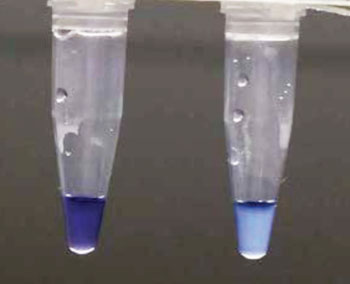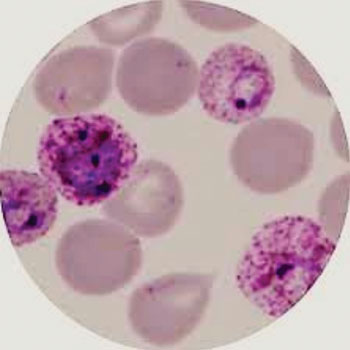High-Throughput LAMP Assay Targets Benign Tertian Malaria
|
By LabMedica International staff writers Posted on 28 Feb 2016 |

Image: High-throughput loop-mediated isothermal amplification (HtLAMP) color change associated with hydroxynaphtholblue (HNB); left clear, purple color is negative and right cloudy, blue color positive for Plasmodium vivax (Photo courtesy of QIMR Berghofer Medical Research Institute).

Image: Photomicrograph of Plasmodium vivax malaria parasites in a thin blood smear (Photo courtesy of the Pasteur Institute Cambodia).
Diagnostic tools for Plasmodium vivax infection, also known as benign tertian malaria, in non-reference laboratory settings are limited to microscopy and rapid diagnostic tests (RDT) but these are unreliable at low parasitemia.
Based on a DNA amplification technology called loop-mediated isothermal amplification (LAMP), an assay has been developed and validated using colorimetric, high throughput assay (HtLAMP) suitable for the detection of P. vivax infection in non-referral settings.
An international team of scientists led by those at the University of Queensland (Brisbane, Australia) developed high-throughput LAMP assay targeting a P. vivax mitochondrial gene and deploying colorimetric detection in a 96-well plate format was developed and evaluated in the laboratory. Diagnostic accuracy was compared against microscopy, antigen detection tests and polymerase chain reaction (PCR) and validated in samples from malaria patients and community controls in a district hospital setting in Sabah, Malaysia.
The limit of detection of the HtLAMP-Pv assay was compared with the SD Bioline Pf/Pan RDT (Alere Standard Diagnostics; Yongin-si, Republic of Korea). Blood samples were collected from microscopy positive, symptomatic patients presenting as outpatients and asymptomatic, microscopy negative, community controls as a result of reactive active case detection and these were stored as 20 μL filter paper blood spots. A subset of 149 microscopy positive samples and 112 microscopy negative samples were used to compare the performance of the P. vivax HtLAMP (HtLAMP-Pv), with microscopy and PCR. High throughput (HtLAMP) was performed on a 96-well standard U-bottom microtiter plate. The microtiter plate was then read in an enzyme-linked immunosorbent assay (ELISA) plate reader at 600 nm wavelength to obtain an optical density (OD) reading of each well.
The HtLAMP-Pv assay performed with an estimated limit of detection of 1.4 parasites/ μL. Assay primers demonstrated cross-reactivity with P. knowlesi but not with other Plasmodium spp. Field testing of HtLAMP-Pv was conducted using 149 samples from symptomatic malaria patients (64 P. vivax, 17 P. falciparum, 56 P. knowlesi, seven P. malariae, one mixed P. knowlesi/P. vivax, with four excluded). When compared against multiplex PCR, HtLAMP-Pv demonstrated a sensitivity for P. vivax of 95% (61/64), and specificity of 100% (25/25) when P. knowlesi samples were excluded. HtLAMP-Pv testing of 112 samples from asymptomatic community controls, seven of which had submicroscopic P. vivax infections by PCR, showed a sensitivity of 71% (5/7) and specificity of 93% (98/105).
The authors concluded that the development and validation of a novel P. vivax-specific LAMP assay which combines a low limit of detection with a high throughput, colorimetric, field applicable molecular diagnostic assay. As such, the HtLAMP assay holds much promise as a diagnostic tool to support malaria elimination efforts in resource-limited P. vivax endemic settings. The study was published on February 12, 2016, in the journal Public Library of Science Neglected Tropical Diseases.
Related Links:
University of Queensland
Alere Standard Diagnostics
Based on a DNA amplification technology called loop-mediated isothermal amplification (LAMP), an assay has been developed and validated using colorimetric, high throughput assay (HtLAMP) suitable for the detection of P. vivax infection in non-referral settings.
An international team of scientists led by those at the University of Queensland (Brisbane, Australia) developed high-throughput LAMP assay targeting a P. vivax mitochondrial gene and deploying colorimetric detection in a 96-well plate format was developed and evaluated in the laboratory. Diagnostic accuracy was compared against microscopy, antigen detection tests and polymerase chain reaction (PCR) and validated in samples from malaria patients and community controls in a district hospital setting in Sabah, Malaysia.
The limit of detection of the HtLAMP-Pv assay was compared with the SD Bioline Pf/Pan RDT (Alere Standard Diagnostics; Yongin-si, Republic of Korea). Blood samples were collected from microscopy positive, symptomatic patients presenting as outpatients and asymptomatic, microscopy negative, community controls as a result of reactive active case detection and these were stored as 20 μL filter paper blood spots. A subset of 149 microscopy positive samples and 112 microscopy negative samples were used to compare the performance of the P. vivax HtLAMP (HtLAMP-Pv), with microscopy and PCR. High throughput (HtLAMP) was performed on a 96-well standard U-bottom microtiter plate. The microtiter plate was then read in an enzyme-linked immunosorbent assay (ELISA) plate reader at 600 nm wavelength to obtain an optical density (OD) reading of each well.
The HtLAMP-Pv assay performed with an estimated limit of detection of 1.4 parasites/ μL. Assay primers demonstrated cross-reactivity with P. knowlesi but not with other Plasmodium spp. Field testing of HtLAMP-Pv was conducted using 149 samples from symptomatic malaria patients (64 P. vivax, 17 P. falciparum, 56 P. knowlesi, seven P. malariae, one mixed P. knowlesi/P. vivax, with four excluded). When compared against multiplex PCR, HtLAMP-Pv demonstrated a sensitivity for P. vivax of 95% (61/64), and specificity of 100% (25/25) when P. knowlesi samples were excluded. HtLAMP-Pv testing of 112 samples from asymptomatic community controls, seven of which had submicroscopic P. vivax infections by PCR, showed a sensitivity of 71% (5/7) and specificity of 93% (98/105).
The authors concluded that the development and validation of a novel P. vivax-specific LAMP assay which combines a low limit of detection with a high throughput, colorimetric, field applicable molecular diagnostic assay. As such, the HtLAMP assay holds much promise as a diagnostic tool to support malaria elimination efforts in resource-limited P. vivax endemic settings. The study was published on February 12, 2016, in the journal Public Library of Science Neglected Tropical Diseases.
Related Links:
University of Queensland
Alere Standard Diagnostics
Latest Microbiology News
- Handheld Device Delivers Low-Cost TB Results in Less Than One Hour
- New AI-Based Method Improves Diagnosis of Drug-Resistant Infections
- Breakthrough Diagnostic Technology Identifies Bacterial Infections with Almost 100% Accuracy within Three Hours
- Innovative ID/AST System to Help Diagnose Infectious Diseases and Combat AMR
- Gastrointestinal Panel Delivers Rapid Detection of Five Common Bacterial Pathogens for Outpatient Use
- Rapid PCR Testing in ICU Improves Antibiotic Stewardship
- Unique Genetic Signature Predicts Drug Resistance in Bacteria
- Unique Barcoding System Tracks Pneumonia-Causing Bacteria as They Infect Blood Stream
- Rapid Sepsis Diagnostic Test Demonstrates Improved Patient Care and Cost Savings in Hospital Application
- Rapid Diagnostic System to Detect Neonatal Sepsis Within Hours
- Novel Test to Diagnose Bacterial Pneumonia Directly from Whole Blood
- Interferon-γ Release Assay Effective in Patients with COPD Complicated with Pulmonary Tuberculosis
- New Point of Care Tests to Help Reduce Overuse of Antibiotics
- 30-Minute Sepsis Test Differentiates Bacterial Infections, Viral Infections, and Noninfectious Disease
- CRISPR-TB Blood Test to Enable Early Disease Diagnosis and Public Screening
- Syndromic Panel Provides Fast Answers for Outpatient Diagnosis of Gastrointestinal Conditions
Channels
Clinical Chemistry
view channel
Low-Cost Portable Screening Test to Transform Kidney Disease Detection
Millions of individuals suffer from kidney disease, which often remains undiagnosed until it has reached a critical stage. This silent epidemic not only diminishes the quality of life for those affected... Read more
New Method Uses Pulsed Infrared Light to Find Cancer's 'Fingerprints' In Blood Plasma
Cancer diagnoses have traditionally relied on invasive or time-consuming procedures like tissue biopsies. Now, new research published in ACS Central Science introduces a method that utilizes pulsed infrared... Read moreMolecular Diagnostics
view channel
Novel Autoantibody Against DAGLA Discovered in Cerebellitis
Autoimmune cerebellar ataxias are strongly disabling disorders characterized by an impaired ability to coordinate muscle movement. Cerebellar autoantibodies serve as useful biomarkers to support rapid... Read more
Gene-Based Blood Test Accurately Predicts Tumor Recurrence of Advanced Skin Cancer
Melanoma, an aggressive form of skin cancer, becomes extremely difficult to treat once it spreads to other parts of the body. For patients with metastatic melanoma tumors that cannot be surgically removed... Read moreHematology
view channel
New Scoring System Predicts Risk of Developing Cancer from Common Blood Disorder
Clonal cytopenia of undetermined significance (CCUS) is a blood disorder commonly found in older adults, characterized by mutations in blood cells and a low blood count, but without any obvious cause or... Read more
Non-Invasive Prenatal Test for Fetal RhD Status Demonstrates 100% Accuracy
In the United States, approximately 15% of pregnant individuals are RhD-negative. However, in about 40% of these cases, the fetus is also RhD-negative, making the administration of RhoGAM unnecessary.... Read moreImmunology
view channel
Stem Cell Test Predicts Treatment Outcome for Patients with Platinum-Resistant Ovarian Cancer
Epithelial ovarian cancer frequently responds to chemotherapy initially, but eventually, the tumor develops resistance to the therapy, leading to regrowth. This resistance is partially due to the activation... Read more
Machine Learning-Enabled Blood Test Predicts Immunotherapy Response in Lymphoma Patients
Chimeric antigen receptor (CAR) T-cell therapy has emerged as one of the most promising recent developments in the treatment of blood cancers. However, over half of non-Hodgkin lymphoma (NHL) patients... Read morePathology
view channel
Novel UV and Machine Learning-Aided Method Detects Microbial Contamination in Cell Cultures
Cell therapy holds great potential in treating diseases such as cancers, inflammatory conditions, and chronic degenerative disorders by manipulating or replacing cells to restore function or combat disease.... Read more
New Error-Corrected Method to Help Detect Cancer from Blood Samples Alone
"Liquid biopsy" technology, which relies on blood tests for early cancer detection and monitoring cancer burden in patients, has the potential to transform cancer care. However, detecting the mutational... Read more
"Metal Detector" Algorithm Hunts Down Vulnerable Tumors
Scientists have developed an algorithm capable of functioning as a "metal detector" to identify vulnerable tumors, marking a significant advancement in personalized cancer treatment. This breakthrough... Read more
Novel Technique Uses ‘Sugar’ Signatures to Identify and Classify Pancreatic Cancer Cell Subtypes
Pancreatic cancer is often asymptomatic in its early stages, making it difficult to detect until it has progressed. Consequently, only 15% of pancreatic cancers are diagnosed early enough to allow for... Read moreTechnology
view channel
Pain-On-A-Chip Microfluidic Device Determines Types of Chronic Pain from Blood Samples
Chronic pain is a widespread condition that remains difficult to manage, and existing clinical methods for its treatment rely largely on self-reporting, which can be subjective and especially problematic... Read more
Innovative, Label-Free Ratiometric Fluorosensor Enables More Sensitive Viral RNA Detection
Viruses present a major global health risk, as demonstrated by recent pandemics, making early detection and identification essential for preventing new outbreaks. While traditional detection methods are... Read moreIndustry
view channel
Cepheid and Oxford Nanopore Technologies Partner on Advancing Automated Sequencing-Based Solutions
Cepheid (Sunnyvale, CA, USA), a leading molecular diagnostics company, and Oxford Nanopore Technologies (Oxford, UK), the company behind a new generation of sequencing-based molecular analysis technologies,... Read more
Grifols and Tecan’s IBL Collaborate on Advanced Biomarker Panels
Grifols (Barcelona, Spain), one of the world’s leading producers of plasma-derived medicines and innovative diagnostic solutions, is expanding its offer in clinical diagnostics through a strategic partnership... Read more






















